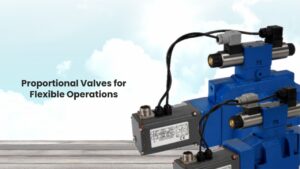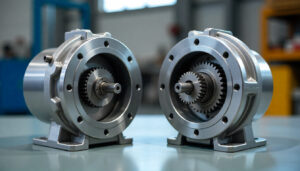The hydraulic world has directional control valves that are significant in regulating the direction of flow of a fluid in a system. These parts are required in a 2-way, 3-way, or 4-way directional valve to make sure that machinery is moved and operates in the correct manner in many industrial applications.
Be it a construction equipment or a manufacturing system, the correct choice of the hydraulic directional valve is core to precision, safety and performance.
Key Functions:
- Opens, closes, or reverses the direction of fluid flow
- Controls direction of actuator (e.g. cylinder or motor)
- Operates together with other valves to regulate pressure and flow
Types of Directional Control Valves
- 2-Way Directional Valve
Only one input and output port
Allows unidirectional or does not allow unidirectional flow
Broad application in basic on/off loading
- 3-Way Directional Valve
One inlet and two outlet ports
Used as a flow switch path
Single-acting cylinders
- 4-Way Directional Valve
Two inlet ports and two outlet ports
Applied mostly in the double-acting cylinders
Allows forward, reverse and neutral flow.
Pneumatic Directional Valves vs. Solenoid
Solenoid Directional Valve
Electrically operated, via a solenoid coil
Quick and accurate
Found on automation and CNC systems
Pneumatic Directional Valve
Worked by compressed air
Commonly applied in places that electricity is inapplicable
Less complex and cheaper.
Each of the two types is applicable based on the system environment and functional requirements.
The necessity of Directional Valves in Hydraulic Accuracy
- Precision Fluid Control
Directional valves control the fluid flow direction and location. This eliminates the possibility of pressure accumulation and makes actuators work on demand.
- System Safety
Improper fluid flow may result in broken machinery. These valves prevent the flow when required and make the system safe to operate.
- Improved Efficiency
With the fluid motion controlled you minimize energy waste. This results in easier running and less maintenance expenses.
- Automation Compatibility
Sophisticated systems incorporate solenoid directional valves with sensors and controllers to perform intelligently in industrial automation.
Directional valves are used where?
Some of the sectors that use industrial directional valves include:
- Robotic arm and press manufacturing facilities
- Loaders and excavators and other construction machines
- Farming machines such as harvesters
- Injection molding machines
- Hydraulic cranes and lifts
Guidelines to Selecting the Appropriate Directional Control Valve
To select the proper valve, system requirements must be known. Expert tips here are:
- Be Aware of Flow Paths Number
Choose either 2-way, 3-way or 4-way depending on the needed fluid paths.
- Take Actuation Type
Do you require manual, solenoid or pneumatic actuation?
- Operating Pressure & Flow
Make sure the valve is capable of passing the working pressure and fluid volume of your system.
- Response Time
High-speed automation or precision applications are well served with faster response.
- Material Compatibility
Select a valve body material that is resistant to your hydraulic fluid.
Tips to maintain and use it long term
With the correct care, your hydraulic directional valve will last longer:
- Clean valve ports and seals regularly
- Inspect and see if there are leaks or abnormal wear
- Broken solenoids or springs should be replace at once
- Plan a preventative maintenance on a routine basis
Conclusion: The Backbone of Hydraulic Accuracy
A directional control valve is the workhorse of any hydraulic system that must be accurate. It could be a solenoid directional valve use in industrial automation or a 4-way directional valve use in heavy machinery, the right valve will make operations safe, accurate, and efficient.
There are reputable brands such as THM Huade which supply hydraulic directional valves of high quality, designed to be durable and precise. The valve selection and maintenance is not to be underestimated. It might appear that a high quality hydraulic directional valve is costly; however, it will pay off in the long term due to its durability.
FAQs:
Q: 1 What are directional control valves used for?
They regulate the flow direction of hydraulic or pneumatic fluid in systems to specific actuators such as cylinders or motors to provide desired motions.
Q: 2 How are directional control valves classified?
They are categorized as per the number of ports (2-way, 3-way, 4-way), positions (2 or 3), and the type of actuation such as manual, solenoid, or pneumatic.
Q: 3 How does a 4/3 directional control valve work?
It is a four-port three-position valve used to control double-acting actuators, to select between forward, reverse, or neutral (blocked or floating) flow modes.
Q: 4 What is the difference between a 3-way valve and a 4-way valve?
A 3-way valve is use with one actuator port and one exhaust, whereas a 4-way valve is use with two actuator ports to move in two directions.
Q: 5 What is the directional main control valve?
The most usual is the 4-way, 3-position valve, which is very common in hydraulic systems to operate double-acting cylinders and motors.



